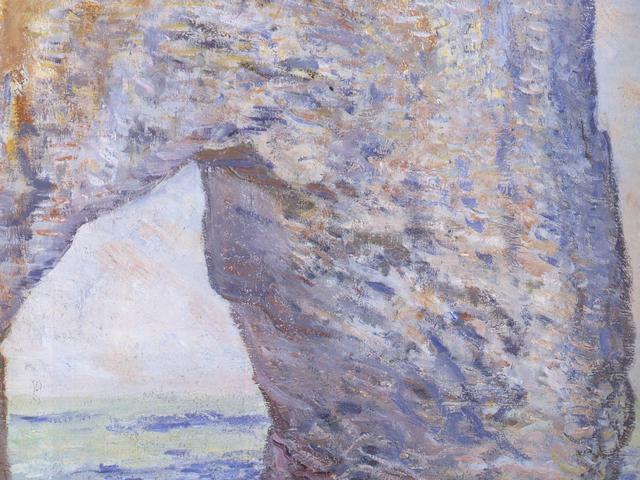El Manneporte (Etretat)

The Manneporte was a work of art made by the impressionist artist, Claude Monet. He used oil on canvas as a medium with brush strokes as a technique. As you can see, you can see how the colors capture the light as you look at the sky, the rock formation, and the waters. The Manneporte is a huge natural arch jutting out of the sea on Etretat beach, which caught Monet's attention during his stay on the Channel coast in the early months of 1883.
Monet spent most of February 1883 in Etretat, a fishing village and resort on the Normandy coast. He painted twenty views of the beach and the three extraordinary rock formations in the area: the Porte d'Aval, the Porte d'Amont and the Manneporte. The sunlight hitting the Manneporte has a dematerializing effect that allowed the artist to interpret the cliff almost exclusively in terms of color and luminosity. Most 19th century visitors were attracted to the rock as a natural wonder. Instead, Monet focused on his own changing perception of it at different times of the day.
Monet created quite a bit of visual texture in this painting. The brush stroke in the lower region forms the waves, while the more linear and slightly softer strokes form the rock. Using a lighter, warmer shade of gray on the interior face of the rock wall adds dimensions to the composition as well as depth.
Claude Monet was the driving force behind French Impressionism, specializing in air painting, a technique exemplified in this work, which also illustrates most of the characteristics of Impressionist painting of the time. Other Impressionists who devoted themselves to plein air work were Camille Pissarro (1830-1903), Alfred Sisley (1839-1899) and, to a lesser extent, Auguste Renoir (1841-1919). In 1883, Monet settled in Giverny, where he created his famous water garden, and continued painting water lilies (see Decoration des Nympheas 1916-26, Musée de l'Orangerie, Paris) until his death, anticipating later 20th-century styles such as Abstract Expressionism (1945-1960).
© Tourblink